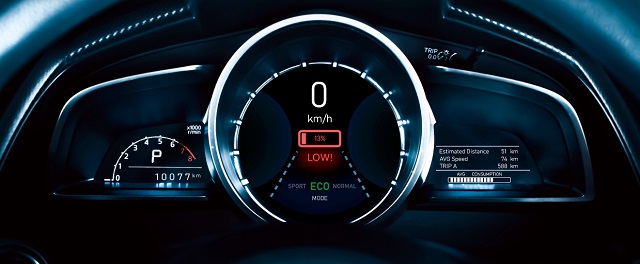Automotive
The Pawns Push Back against the Trudeau Government’s Electric Vehicle Diktats

From the C2C Journal
By Gwyn Morgan
Perhaps there is a certain twisted logic to the woke left’s attempt to convince schoolchildren that math is racist and that 2 plus 2 might well equal 5. For this may be the only way to get the “math” surrounding the Justin Trudeau government’s push to force Canadians into buying only electric vehicles as of 2035 to work in any way at all. Gwyn Morgan reviews the actual math of key elements of the EV transition scheme – the electric power needs, the subsidized purchases, the tax credits, the vast number of required charging stations, the maintenance of roads – and finds both the costs and the implementation obstacles to be a mixture of steep, dubious and prohibitive. So much so, Morgan concludes, as to cast the entire EV transition in doubt.
Automotive
Canada’s EV experiment has FAILED

By Dan McTeague
The government’s attempt to force Canadians to buy EVs by gambling away billions of tax dollars and imposing an EV mandate has been an abject failure.
GM and Stellantis are the latest companies to back track on their EV plans in Canada despite receiving billions in handouts from Canadian taxpayers.
Dan McTeague explains in his latest video.
Automotive
Carney’s Budget Risks Another Costly EV Bet

From the Frontier Centre for Public Policy
GM’s Ontario EV plant was sold as a green success story. Instead it collapsed under subsidies, layoffs and unsold vans
Every age invents new names for old mistakes. In ours, they’re sold as investments. Before the Carney government unveils its November budget promising another future paid for in advance, Canadians should remember Ingersoll, Ont., one of the last places a prime minister tried to buy tomorrow.
Eager to transform the economy, in December 2022, former prime minister Justin Trudeau promised that government backing would help General Motors turn its Ingersoll plant into a beacon of green industry. “By 2025 it will be producing 50,000 electric vehicles per year,” he declared: 137 vehicles daily, six every hour. What sounded like renewal became an expensive demonstration of how progressive governments peddle rampant spending as sound strategy.
The plan began with $259 million from Ottawa and another $259 million from Ontario: over half a billion to switch from Equinox production to BrightDrop electric delivery vans. The promise was thousands of “good, middle-class jobs.”
The assembly plant employed 2,000 workers before retooling. Today, fewer than 700 remain; a two-thirds collapse. With $518 million in public funds and only 3,500 vans built in 2024, taxpayers paid $148,000 per vehicle. The subsidy works out to over half a million dollars per remaining worker. Two out of every three employees from Trudeau’s photo-op are now unemployed.
The failure was entirely predictable. Demand for EVs never met the government’s plan. Parking lots filled with unsold inventory. GM did the rational thing: slowed production, cut staff and left. The Canadian taxpayer was left to pay the bill.
This reveals the weakness of Ottawa’s industrial policy. Instead of creating conditions for enterprise, such as reliable energy, stable regulation, and moderate taxes, progressive governments spend to gain applause. They judge success by the number of jobs announced, yet those jobs vanish once the cameras leave.
Politicians keep writing cheques to industry. Each administration claims to be more strategic, yet the pattern persists. No country ever bought its way into competitiveness.
Trudeau “bet big on electric vehicles,” but betting with other people’s money isn’t vision; it’s gambling. The wager wasn’t on technology but narrative, the naive idea that moral intention could replace market reality. The result? Fewer jobs, unwanted products and claims of success that convinced no one.
Prime Minister Mark Carney has mastered the same rhetorical sleight of hand. Spending becomes “investment,” programs become “platforms.” He promises to “catalyze unprecedented investments” while announcing fiscal restraint: investing more while spending less. His $13-billion federal housing agency is billed as a future investment, though it’s immediate public spending under a moral banner.
“We can build big. Build bold. Build now,” Carney declared, promising infrastructure to “reduce our vulnerabilities.” The cadence of certainty masks the absence of limits. Announcing “investment” becomes synonymous with action itself; ambition replaces accountability.
The structure mirrors the Ingersoll case: promise vast returns from state-directed spending, redefine subsidy as vision, rely on tomorrow to conceal today’s bill. “Investment” has become the language of evasion, entitlement and false pride.
As Carney prepares his first budget, Canadians should remember what happened when their last leader tried to buy a future with lavish “investment.”
A free economy doesn’t need bribery to breathe. It requires the discipline of risk and liberty to fail without dragging a country down. Ingersoll wasn’t undone by technology but by ideological conceit. Prosperity cannot be decreed and markets cannot be commanded into obedience.
Every age invents new names for old mistakes. Ours keeps making the same ones. Entitled hubris knows no bounds.
Marco Navarro-Genie is vice-president of research at the Frontier Centre for Public Policy and co-author, with Barry Cooper, of Canada’s COVID: The Story of a Pandemic Moral Panic (2023).
-

 Business2 days ago
Business2 days agoTrans Mountain executive says it’s time to fix the system, expand access, and think like a nation builder
-

 International2 days ago
International2 days agoBiden’s Autopen Orders declared “null and void”
-

 MAiD2 days ago
MAiD2 days agoStudy promotes liver transplants from Canadian euthanasia victims
-

 Business2 days ago
Business2 days agoCanada has given $109 million to Communist China for ‘sustainable development’ since 2015
-

 Internet2 days ago
Internet2 days agoMusk launches Grokipedia to break Wikipedia’s information monopoly
-

 Business2 days ago
Business2 days agoCanada’s combative trade tactics are backfiring
-

 Automotive2 days ago
Automotive2 days agoCarney’s Budget Risks Another Costly EV Bet
-

 Business2 days ago
Business2 days agoYou Won’t Believe What Canada’s Embassy in Brazil Has Been Up To


 The cost of a charge: Research suggests that adding millions of EVs to Canadian roads would require an over 15 percent increase in nationwide electricity supply – equivalent to 10 large hydroelectric dams the size of B.C.’s $16 billion Site C Dam on the Peace River (bottom). (Source of bottom photo: BC Hydro)
The cost of a charge: Research suggests that adding millions of EVs to Canadian roads would require an over 15 percent increase in nationwide electricity supply – equivalent to 10 large hydroelectric dams the size of B.C.’s $16 billion Site C Dam on the Peace River (bottom). (Source of bottom photo: BC Hydro) Good luck with that: The Government of Canada claims its $680 million Zero Emission Vehicle Infrastructure Program will help get nearly 85,000 charging stations built. But in the U.S., President Joe Biden’s US$7.5 billion charging station construction program has produced just eight charging stations in two-and-a-half years. (Sources of photos: (top) Marc Bruxelle/Shutterstock; (bottom)
Good luck with that: The Government of Canada claims its $680 million Zero Emission Vehicle Infrastructure Program will help get nearly 85,000 charging stations built. But in the U.S., President Joe Biden’s US$7.5 billion charging station construction program has produced just eight charging stations in two-and-a-half years. (Sources of photos: (top) Marc Bruxelle/Shutterstock; (bottom) 
 The human cost of a “green” future: Depicted is the main cobalt mining site in the Democratic Republic of Congo, where 75 percent of this critical input to EV batteries is mined; as one recent academic report notes, this hazardous industry has “dire effects on human well-being”, including on physical and mental health, and often involves child-labour and human rights abuses. (Source of photos: Siddharth Kara, retrieved from
The human cost of a “green” future: Depicted is the main cobalt mining site in the Democratic Republic of Congo, where 75 percent of this critical input to EV batteries is mined; as one recent academic report notes, this hazardous industry has “dire effects on human well-being”, including on physical and mental health, and often involves child-labour and human rights abuses. (Source of photos: Siddharth Kara, retrieved from  Like philosopher Adam Smith’s (top left) “man of the system”, Justin Trudeau (top right) tries to arrange people as if they are “pieces upon a chessboard”; but the thousands of unsold EVs filling vast parking lots in China, the U.S. and seaports around the world suggest car-buying consumers are still capable of independent decision-making. (Sources of photos: (top right) The Canadian Press/Chad Hipolito; (bottom) Golden Shrimp/Shutterstock)
Like philosopher Adam Smith’s (top left) “man of the system”, Justin Trudeau (top right) tries to arrange people as if they are “pieces upon a chessboard”; but the thousands of unsold EVs filling vast parking lots in China, the U.S. and seaports around the world suggest car-buying consumers are still capable of independent decision-making. (Sources of photos: (top right) The Canadian Press/Chad Hipolito; (bottom) Golden Shrimp/Shutterstock)




